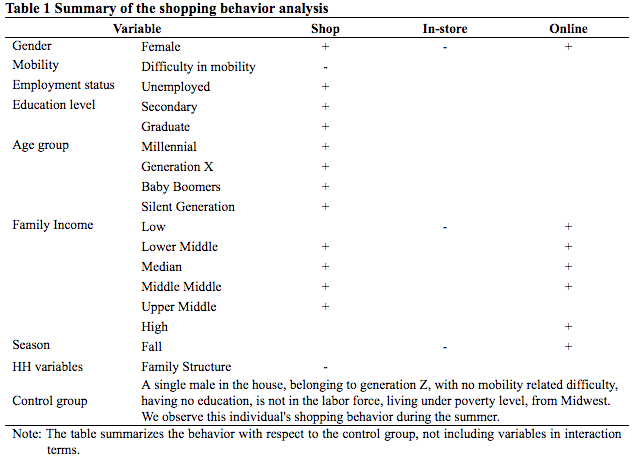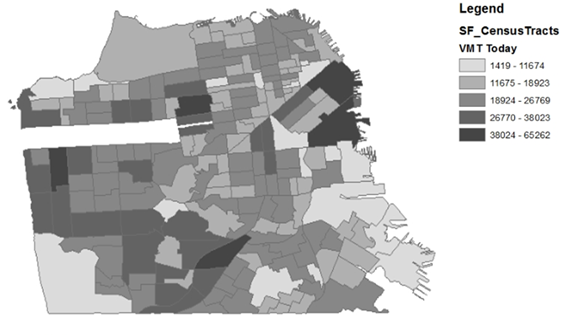Corresponding Author: Miguel Jaller
With the advent of internet, various fields and sectors have witnessed a transformation. The retail sector in particular has witnessed a massive growth of e-commerce in the last decade. This has significantly transformed our shopping experience and is influencing our shopping decisions, be it where to shop, what to shop, or how much to shop. With the consistent growth in e-commerce transactions, more trucks enter the city today than have ever before, thus, bringing along the negative externalities of congestion and pollution.
This study first unravels the underlying shopping behavior–in-store and online–using the 2016 American Time Use Survey (ATUS) data. Additionally, the authors develop a number of econometric models to understand the factors that affect shopping decisions, in general, and in-store and online, in particular. The authors magnify, to a macro level, the underlying disaggregate individual shopping behaviors by implementing the models to synthetic populations, to estimate the potential vehicle miles traveled and environmental emissions in two metropolitan areas. Table 1 summarizes the results from these econometric models.

To estimate the impacts of shopping, the authors conducted environmental analyses for two large metropolitan areas: Dallas and the city of San Francisco. Using the 2010 Census Data, the authors generated a synthetic population replicating the inhabitants in the census tracts for these cities. The authors implemented the behavioral models to each individual to determine how many would shop, in general, as well as how many would shop in-store and online. After estimating the shopping behavior, the study estimated the vehicle miles traveled (VMT) and emissions generated by the population’s shopping activity. The authors used data from the 2017 National Household Travel Survey (NHTS) and from the National Renewable Energy Laboratory (NREL) to define shopping as trips/tours, and commercial vehicle delivery distances for the analyses.
The impacts have been studied for three scenarios: “Omni-Channel”, replicating today’s shopping behavior; a second scenario, “Single Channel (SC) in-store” with all people shopping in-store, replicating the traditional method of shopping; and a potential scenario for the future, “Single Channel (SC) online”, where all those who shop, shop online. The study tests each of these three scenarios for three cases of delivery tour length–base case with median value of tour length, case 1 using the 1st quartile value, and case 2 using the 3rd quartile value of tour lengths. Figure 1 shows the daily estimates of VMT for San Francisco for “Omni-channel” scenario.

Figure 1 Daily estimates for San Francisco using estimated models and synthetic population
This paper evaluates the impacts of e-commerce by estimating the environmental degradation observed today compared to when e-commerce was not a popular channel, i.e., when everyone who shopped, shopped in store. Table 2 shows that an e-commerce dominated market can produce significant reductions in VMT, however, NOx emissions can still increase. And for the current condition, where individuals may shop online and in-store during the same day, all the externalities tend to increase. Hence, one can conclude that the benefits from online shopping are highly dependent on the efficiency of the delivery distribution (i.e., number of stops per tour, and delivery tour distance).

Finally, the authors conducted a breakeven analysis and compared the scenarios in terms of the minimum number of customers (stops) catered in one single delivery tour to understand the impact of rush deliveries. Such a breakeven value would however vary with the parameters used across the scenarios. The breakeven values vary from 6 to 138. If there are less than 6 deliveries consolidated in a delivery tour, all parameters perform poorly for e-commerce compared to in-store shopping, Moreover, if more than 138 deliveries are consolidated in a delivery tour, e-commerce performs better than in-store shopping on every aspect. Assuming the industry average of 35 deliveries per tour, there are improvements in all the parameters except for NOx. However, as rush deliveries become more common, it is likely that PM10 and PM2.5 will also become critical. This is because, the rush deliveries do not allow for high level of consolidation.
Conclusions
This study analyzed shopping behavior, in general, as well as in-store and online shopping, using the 2016 ATUS data. Consistent with previous research, the study found females, the higher educated, the employed, and the higher income individuals to be more likely to shop. Interestingly, a higher proportion of kids in the household increases the chances of shopping. This is because higher household needs due to children, leads to a higher probability of shopping. For in-store and online shopping, only gender, family income, and season are the key factors influencing choices. While females are more likely to shop online, they are less likely to shop in-store compared to males. For the seasonal effects, fall observes a hike in online shopping, but a dip in in-store shopping (because of online sales during the holidays). The study did not find regional differences in shopping behavior.
In terms of substitution and complementary effects, first of all, it is important to note that substitution and complementary effects must only be discussed for each shopping category separately (for example, grocery shopping or shopping books). Generalizing substitution or complementary effects over the entire shopping behavior leads to aggregation impacts. However, the authors found a reduction in probability of shopping through one channel when the individual had already shopped in the other. Table 2 shows the magnitude of the vehicle miles traveled and emissions from in-store and online shopping. Comparing traditional shopping (“Single channel in-store”) with the current scenario (“Omni-channel”), the authors found that vehicle miles traveled and emission levels have increased today. This lack of substantial reductions in externalities can be ascribed to the inadequate number of people shopping online on any given day along with insufficient substitution for in-store with online shopping. However, if everyone was to switch to only online shopping, some of the parameters such as VMT would observe a significant decrease, while, NOx emissions could significantly increase.
